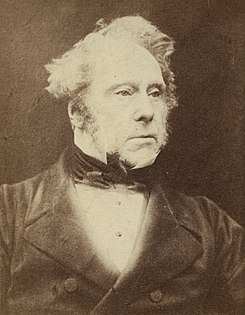Henry John Temple, 3rd Viscount Palmerston
|
The Right Honourable The Viscount Palmerston KG GCB PC FRS |
|
|---|---|

Lord Palmerston c. 1857
|
|
| Prime Minister of the United Kingdom | |
|
In office 12 June 1859 – 18 October 1865 |
|
| Monarch | Victoria |
| Preceded by | The Earl of Derby |
| Succeeded by | The Earl Russell |
|
In office 6 February 1855 – 19 February 1858 |
|
| Monarch | Victoria |
| Preceded by | The Earl of Aberdeen |
| Succeeded by | The Earl of Derby |
| Leader of the Opposition | |
|
In office 19 February 1858 – 11 June 1859 |
|
| Monarch | Victoria |
| Prime Minister | The Earl of Derby |
| Preceded by | The Earl of Derby |
| Succeeded by | The Earl of Derby |
| Home Secretary | |
|
In office 28 December 1852 – 6 February 1855 |
|
| Prime Minister | The Earl of Aberdeen |
| Preceded by | Spencer Horatio Walpole |
| Succeeded by | Sir George Grey, Bt |
| Secretary of State for Foreign Affairs | |
|
In office 6 July 1846 – 26 December 1851 |
|
| Prime Minister | Lord John Russell |
| Preceded by | The Earl of Aberdeen |
| Succeeded by | The Earl Granville |
|
In office 18 April 1835 – 2 September 1841 |
|
| Prime Minister |
The Viscount Melbourne Sir Robert Peel, Bt |
| Preceded by | The Duke of Wellington |
| Succeeded by | The Earl of Aberdeen |
|
In office 22 November 1830 – 15 November 1834 |
|
| Prime Minister |
The Earl Grey The Viscount Melbourne |
| Preceded by | The Earl of Aberdeen |
| Succeeded by | The Earl Granville |
| Personal details | |
| Born |
20 October 1784 Westminster, Middlesex, England |
| Died | 18 October 1865 (aged 80) Brocket Hall, Hertfordshire, England |
| Political party |
Tory (1806–1822) Whig (1822–1859) Liberal (1859–1865) |
| Spouse(s) | Emily Lamb (m. 1839) |
| Alma mater | University of Edinburgh, University of Cambridge |
| Religion | Church of England |
| Signature | |
Henry John Temple, 3rd Viscount Palmerston, KG, GCB, PC, FRS (20 October 1784 – 18 October 1865) was a British statesman who served twice as Prime Minister in the mid-19th century. For most of 1830 to 1865 he dominated British foreign policy when Britain was at the height of her power. Popularly nicknamed "Pam" and "The Mongoose", he was in government office almost continuously from 1807 until his death in 1865, beginning his parliamentary career as a Tory, switching to the Whigs in 1830, and concluding it as the first Prime Minister of the newly-formed Liberal Party from 1859.
He succeeded to his father's Irish peerage in 1802. He became a Tory MP in 1807, and was made Secretary at War in 1809, responsible for the finances of the army. He held the job until 1828, entering the cabinet in 1827 when George Canning became Prime Minister. Less than a year later he resigned with other Canningites.
In opposition he switched his focus to foreign policy, and he was Foreign Secretary (1830-4, 1835–41 and 1846–51) when the Whigs were in power, dealing with a succession of crises in Europe and beyond. Some of his aggressive actions, now sometimes termed liberal interventionist, were highly controversial at the time, and remain so today. In 1852 he became Home Secretary in Aberdeen's coalition government, the Peelites having insisted on Russell getting the Foreign Office. He passed various social reforms but opposed electoral ones. When public discontent over the Crimean War brought the government down in 1855, Palmerston was found to be, despite the Queen's distrust of him, the only Prime Minister who could sustain a majority in Parliament. He had two periods in office, 1855–1858 and 1859–1865, before dying at almost 81, a few months after winning a general election with an increased majority. He remains, to date, the last Prime Minister to die in office.
...
Wikipedia
